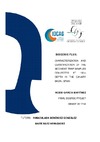Identificador persistente para citar o vincular este elemento:
https://accedacris.ulpgc.es/jspui/handle/10553/74991
| Campo DC | Valor | idioma |
|---|---|---|
| dc.contributor.advisor | Menéndez González, Inmaculada | - |
| dc.contributor.advisor | Báez Hernández, Maite | - |
| dc.contributor.author | García Martínez, Noemí | - |
| dc.date.accessioned | 2020-10-26T09:58:09Z | - |
| dc.date.available | 2020-10-26T09:58:09Z | - |
| dc.date.issued | 2018 | - |
| dc.identifier.other | Gestión académica | - |
| dc.identifier.uri | https://accedacris.ulpgc.es/handle/10553/74991 | - |
| dc.description.abstract | Aeolian Saharan dust is transported from the Saharan desert to the Atlantic Ocean surface, starting then a sinking process. It is interesting to observe this process in the oceanic-climatic scenario because its iron minerals content (hematite and goethite mainly) that acts as a natural ocean fertilizer. The objective of this work was to study the biogenic particles of the filters collected with a sediment trap on April 2011 in the Canary Basin at 150 m depth and 11.5 miles from the north Coast of Gran Canaria Island (LUCIFER project) and the possible relation of the biogenic flux with the Saharan dust events. The analyzed plume dust was generated in Western Sahara and North of Mauritania. The nocturnal samples especially that of the night of April 4 are those that presented more biogenic material. The main components founded in the samples were foraminifera (calcite), copepods (chitin), gastropods (aragonite) and transparent exopolymer particles. The mean flux of chitin was 25.2 mg m-2 12h-1 and 1.1 mg m-2 12h-1 for foraminiferal flux. If we compare our results with other parameters analyzed in a priori studies, they all show a similar trend. This study helps to quantify the effect of Saharan dust episodes in the biogenic particulate oceanic fluxes. | - |
| dc.language | eng | - |
| dc.relation | Ciclos Lunares y Fertilización Con Hierro. | - |
| dc.subject | 250618 Sedimentología | - |
| dc.subject | 2510 Oceanografía | - |
| dc.subject.other | Saharan dust | - |
| dc.subject.other | Canary islands | - |
| dc.title | Biogenic Flux: characterization and quantification of the sediment trap samples collected at 150 m depth in the Canary basin, Spain | - |
| dc.type | info:eu-repo/semantics/bachelorThesis | - |
| dc.type | BachelorThesis | - |
| dc.contributor.departamento | Departamento de Física | - |
| dc.contributor.facultad | Facultad de Ciencias del Mar | - |
| dc.investigacion | Ciencias | - |
| dc.type2 | Trabajo final de grado | - |
| dc.identifier.matricula | TFT-42286 | - |
| dc.identifier.ulpgc | Sí | - |
| dc.contributor.buulpgc | BU-BAS | - |
| dc.contributor.titulacion | Grado en Ciencias del Mar | - |
| item.fulltext | Con texto completo | - |
| item.grantfulltext | restricted | - |
| crisitem.project.principalinvestigator | Hernández León, Santiago Manuel | - |
| crisitem.advisor.dept | GIR IOCAG: Geología Aplicada y Regional | - |
| crisitem.advisor.dept | IU de Oceanografía y Cambio Global | - |
| crisitem.advisor.dept | Departamento de Física | - |
| Colección: | Trabajo final de grado Restringido ULPGC | |
Visitas
211
actualizado el 27-sep-2025
Descargas
55
actualizado el 27-sep-2025
Google ScholarTM
Verifica
Comparte
Exporta metadatos
Los elementos en ULPGC accedaCRIS están protegidos por derechos de autor con todos los derechos reservados, a menos que se indique lo contrario.
